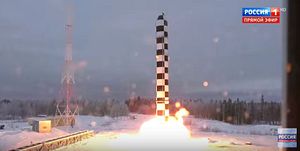Russia is expected to flight test its new silo-based intercontinental-range ballistic missile (ICBM), the super-heavy thermonuclear-armed RS-28 Sarmat (NATO designation: SS-X-30 Satan 2), in early 2019, according to a Russian defense industry source.
“The expected date of launching Sarmat’s flight trials is the beginning of 2019,” the source told TASS news agency on October 2. The first flight test follows the successful completion of ejection or pop-up tests testing the mechanism of the ICBM leaving its launch container or missile silo. (The missile is ejected from its silo by compressed gases before its booster engines are ignited.)
Russia conducted the third and last ejection test of the RS-28 Sarmat at the Plesetsk space center, located in Arkhangelsk Oblast approximately 800 kilometers north of the Russian capital, Moscow, in May 2018. This was preceded by ejection tests in March 2018 and December 2017 respectively. The tests involved the ignition of the Sarmat’s first-stage and booster engine, likely the PDU-99 — a modified version of the RD-274 liquid rocket engine used on the RS-36M2 Voyevoda (NATO designation: SS-18 Satan).
The flight tests in 2019 will involve the launching of the missile’s second- and third-stage engines. As I wrote in July:
The Sarmat can reportedly carry [around] 10 heavy lighter warheads. The new ICBM can allegedly also be fitted with a new [hypersonic boost-glide warhead], the YU-71 [aka Avangard], currently in development under the secret Project 4202. (…) The YU-71 [Avangard] is a warhead purportedly capable of penetrating any Western missile defense system. (…) Each warhead [allegedly] has an explosive yield of up to 750 kilotons.
The Avangard (Vanguard in English) warhead has already entered serial production, according to the Russian government. “The Russian defense industry has completed developing the Avangard missile system with its principal new armament — the hypersonic warhead. Industrial enterprises have switched to serial production [of the Avangard].” the MoD said in a July 19 statement.
One RS-28 will be able to carry three to five Avangard warheads. The Avangard hypersonic boost-glide warhead is expected to be inducted into service in 2019.
Serial production of the missile is slated to begin in 2020. The first Strategic Rocket Force regiment equipped with the RS-28 Sarmat ICBM is expected to deploy by 2021. The RS-28 Sarmat will replace the RS-36M2s currently in service with the Strategic Rocket Force as the mainstay of Russia’s silo-based ICBM force by the mid-2020s. RS-36M2 have two liquid-fuel stages and can carry up to 10 warheads. As of January 2017, the Strategic Rocket Forces field a total of 286 ICBMs armed with a total of 958 warheads.































